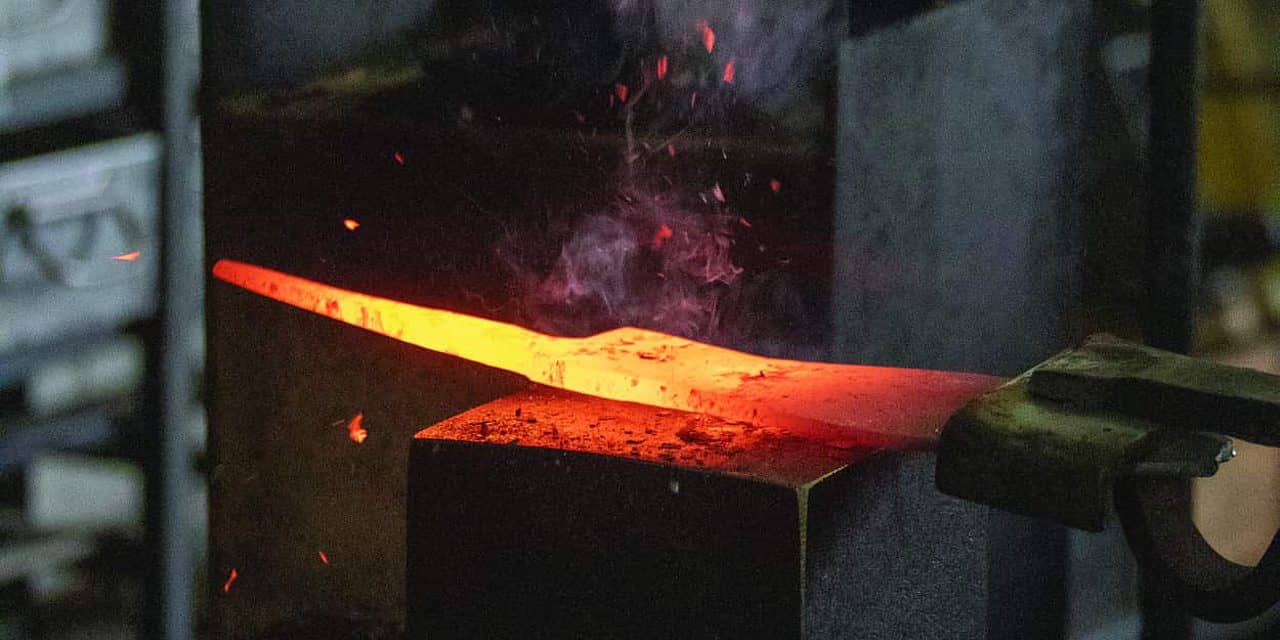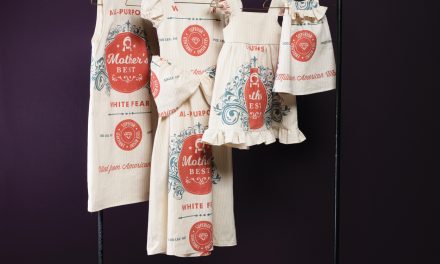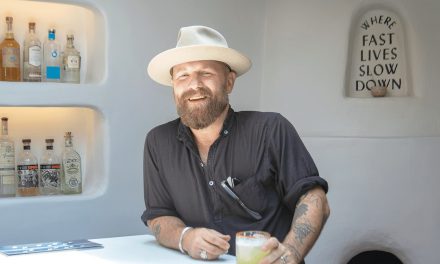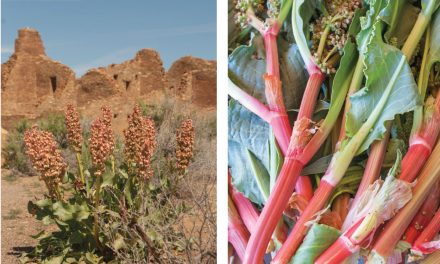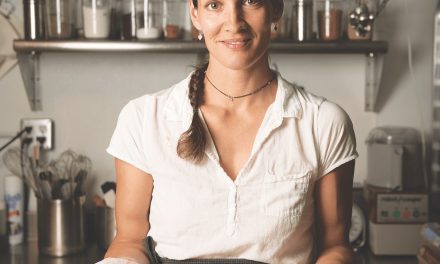Shehan Prull’s Long Journey Back to Santa Fe
By Michael Dax · Photos by Stephanie Cameron
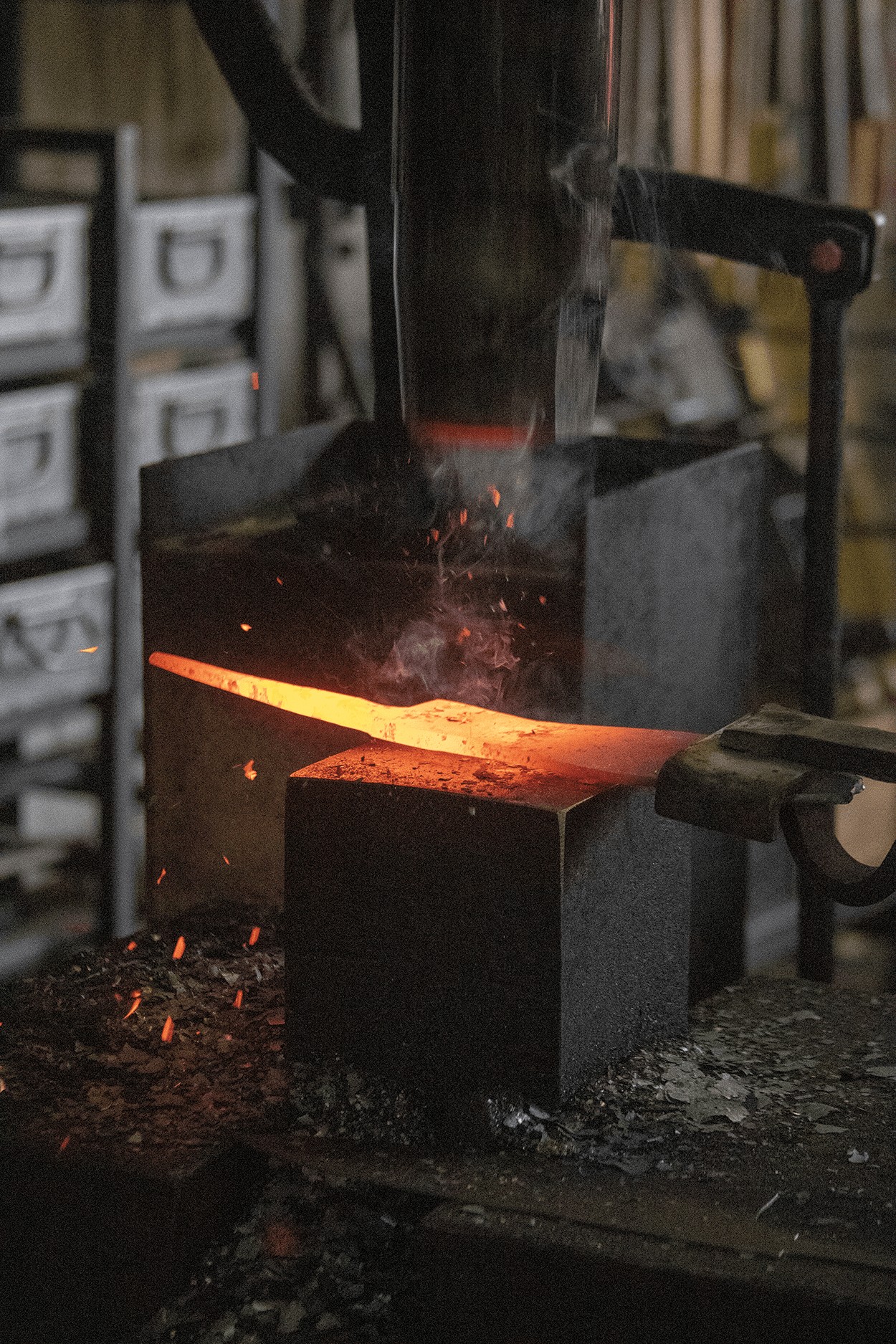
Cars whiz by the nondescript storefront guarded by chain-link fence on Rufina Street as Shehan Prull creates his mixture of pine charcoal and coke, a refined derivative of coal. He shovels a few small loads into the Japanese-style brick forge he constructed himself, and with a handful of paper and some kindling, he lights a fire. Within minutes it is blazing. After the fire has had a chance to reach temperature, Prull, a Santa Fe native, stokes it a couple more times. He casually pushes additional amounts of charcoal and coke onto the fire with his hands, which sport a seemingly permanent gray hue—something blacksmiths have likely endured for millennia.
With the fire fully glowing, Prull places a long, rectangular blade of bar stock made from stainless and high-carbon steel into the flaming hot coals.Within a few minutes, the long, shiny bar has been transformed into a glowing red. He removes it and places it on the anvil adjacent to the forge. Holding the blade in his right hand, Prull hammers with his left, lifting the rectangular head high above his own before swinging down, smoothly but forcefully, and beating a rough point into the previously rigid piece of metal.
After a couple strong blows, he returns the blade to the forge to get it up to temperature again. Upon removing the blade for the second time, Prull places it underneath a hydraulic hammer controlled with his foot. With each stroke, he moves the blade across the platform so that it strikes every inch of the glowing bar to ensure it flattens evenly. He reheats the blade and hammers another round before returning it to the anvil to cut it to size.
Reheating it once again, he places the blade back on the anvil using a set of heavy metal tongs. Prull makes a small cut towards the back of the blade to set the shoulder and create the tang, which will eventually serve as the basis for a handle. When he is finished, the formerly smooth, shiny piece of bar stock has been transformed. It is black and rough, but it has assumed a shape, resembling the knife it will eventually become.
Prull began working with metal when he was eleven years old. Growing up next to world-renowned blacksmith, Tom Joyce, whose ornamental designs are featured across the country, Prull was invited into his studio, and through high school, worked each summer and during holiday breaks as an apprentice to Joyce. Rather than knives, however, Joyce’s training focused on traditional, western-style blacksmithing techniques with a focus on contemporary design, sculpture, and architectural detail.
Prull was ready to forgo college and jump directly into a career in blacksmithing following high school but had doubts about choosing such a definitive and potentially risky career path at such a young age. After spending a year away from his craft at St. Andrews College in Scotland, however, he was more convinced than ever that blacksmithing was his calling. “This offered me a greater combination of things I care about and find interesting,” says Prull. “From the physical aspect, the artistic, the scientific, it had so many components that were stimulating to me, I started to think this is as interesting as anything could be.”
So he returned to Santa Fe and resumed his internship under Joyce, making intricate gates, ornamental handrails, chandeliers, and other such high-end design items. But living in his hometown, Prull grew restless. Inspired by an interest in Japanese language and culture, Prull moved to the Land of the Rising Sun, and eventually secured an apprenticeship outside Osaka under Hiroshi Ashi, a well-known master knife-maker.
Before then, Prull had not worked with knives and didn’t have much interest either. He wanted to do work that required complicated forging, and as he acknowledges, “The forging on knives is pretty repetitive.” But knife-making apprenticeships were the only ones that paid, and after seeing Ashi’s work, he was hooked. “The subtle beauty of the finished work was just spellbinding,” he recalls.
During his two years of working under Ashi, Prull learned techniques like honyaki, which uses a differential heat treatment to produce a ghost line on the knife blade. “When I saw it, I didn’t really understand it,” he remembers. “I thought I had been doing this long enough to have a sense of how pretty much every traditional piece of metal craft is made, and yet I had no idea how they did it.”
This sense of wonder and curiosity drove Prull to learn as much as possible, so that when he returned to Santa Fe in 2009, he was ready to break out on his own. For a few months, he worked under another local blacksmith, Peter Joseph, and when Joseph decided to build a new studio for himself, he offered Prull the opportunity to take over his old workshop and set out on his own.

At first, Prull did some of the same custom ornamental work he had been doing under Joyce and Joseph, but as soon as he could, he turned his focus solely to knives. Since then, he has developed a style that strikes a balance between the light, thinner, and harder Japanese knives and the heavier, thicker, and softer German-style knives.
Most of his retail business has depended on distributing to high-end kitchen stores in cities like San Francisco, Los Angeles, and New Orleans, but he has also been able to make inroads into Santa Fe’s local restaurant scene, and his work has reached a number of prominent local chefs. “They’re spectacular,” says Rocky Durham, executive chef at the Blue Heron Restaurant at Sunrise Springs. “It’s the smartest purchase I’ve ever made with my professional kit.”
“The knives I get from Shehan have quickly become some of my favorite knives,” says Joel Coleman, co-owner and head chef at Fire and Hops. “The quality craftsmanship and attention to detail are pretty impressive.”
As a way of further embedding himself in Santa Fe’s cooking community, Prull occasionally conducts sharpening seminars and has provided same-day sharpening services for the staff of local restaurants. These are opportunities he hopes to expand upon. He already offers sharpening services out of his showroom on Rufina Street, open to any well-crafted set of knives, and he is considering hosting seminars for the general public.
Prull has a number of knives for retail sale in the showroom, along with hand-crafted blade covers, imported Japanese whetstones, and wall-mounted magnetic knife holders. A couple times a year, he also makes small runs of hunting knives and garden trowels, only available in the showroom.
He is excited to share his craft with more of Santa Fe, but recognizes people may balk not only at the price, but also at the care his knives require. The carbon steel can be susceptible to corrosion, so it’s important that the knives are cleaned and dried frequently. “I try to walk the line between not scaring people off because I think it’s really worth it and really rewarding and a bit of patina can be embraced and loved and appreciated.”
This is something Durham acknowledges as well. “You have to maintain them,” he says. “But it’s made me a better cook because it keeps me focused. I have to pay attention to things like what are you going to cut first, did you clean your knife afterwards, let’s maintain that edge really well. It’s become a real discipline and reminder of looking after the details.”
Naturally, Prull has become a bit of a stickler for valuing good knives. “Sharpening and maintaining the knife is so critical to getting all that it has to offer,” says Prull. At the same time, he tries not to take himself too seriously. “I like to think I have a good sense of humor, but definitely think to myself ‘how do [people] live with a dull knife?’”
After the forged blade has had a chance to cool, Prull heats it again in a muffle furnace, where it is held at temperature and cooled slowly so that it remains malleable even once it has returned to room temperature. Using a small, Japanese-style shear, Prull then cuts and shapes the blade so that it fully resembles the finished knife it is inching closer to being.

But because it is so soft, the metal blade must go through one last round of heating and cooling. One of the newest items in Prull’s studio is a salt bath heater, which reaches temperatures as high as 900°C.
Compared to air, the molten salt transfers heat to the blade much faster, saving time, and when Prull cools it, he does so quickly, so that the molecules of the steel set in a pattern that will produce the rigidity and strength required of any good knife.
After the knife is cooled for the last time, it is ready to be sharpened. For this, Prull relies on two water wheel stone sharpeners that cycle through a large water bath, which helps mitigate the amount of unpleasant grinding, a task that initially dissuaded Prull from knife making.
Against a fast-moving wheel that throws off small droplets of water, Prull carefully holds each unsharpened blade to the grindstone, letting speed and friction do the work. A large knife will take as long as twenty-five minutes between the coarse and fine grained wheels to develop the desired edge, but within minutes, much of the blackened roughness has been smoothed away to reveal the glossy sheen that suggests a finished product. Even so, for many of his knives, Prull leaves the top of the blade untouched. “It’s nice to visually show that process—the fact that it was forged,” he says.
Finally, he stamps his logo and engraves his initials by hand into each knife, then adds a handle. Until now, most of his handles have been imported from Japan and are of the same magnolia wood with a water buffalo horn collar that his mentor, Ashi, uses. But he has begun to make his own handles using ash or honey mesquite, complemented with a nickel-silver accent piece. Prull occasionally experiments with other woods, and in the next year is planning to make all of his handles in-house.
It is this complete dedication to craft and attention to detail that initially drew him to this work and has kept him engaged for so long. For him, it’s as much about process as it is the final product. “It’s an arbitrary distinction between craft and art,” he notes. “I may be more of a craftsperson because I care so much about how it was done, not just what it looks like.”
Labels aside, Prull continues to push himself—perfecting techniques, employing new materials, and literally putting his work under a microscope to ensure it is of the highest quality possible. And now that he is firmly settled into his new shop and showroom, Prull is ready to bring fine knives to as many people as possible.
Shi.han 2923 Rufina, Santa Fe, shihanfineknives.com
Edible celebrates New Mexico's food culture, season by season. We believe that knowing where our food comes from is a powerful thing. With our high-quality, aesthetically pleasing and informative publication, we inspire readers to support and celebrate the growers, producers, chefs, beverage and food artisans, and other food professionals in our community.

